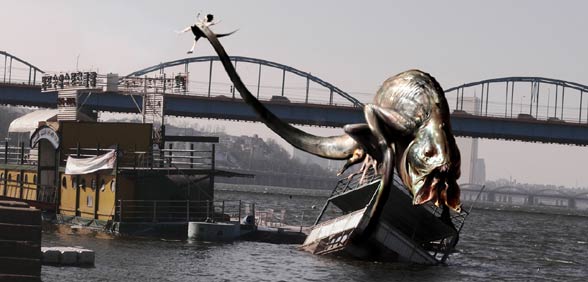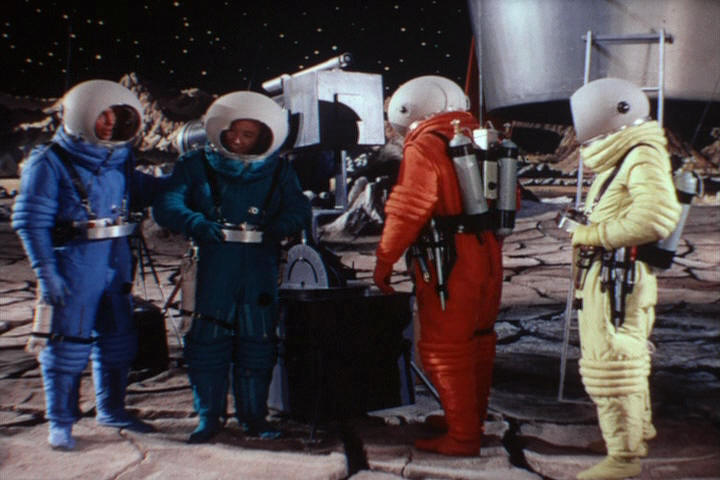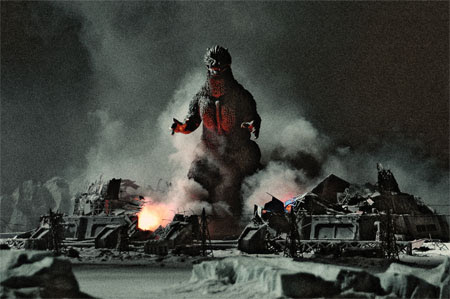THE HOST (Joon-ho Bong, 2006)
THE HOST (Joon-ho Bong, 2006)

The combination of political commentary and monster thriller seems to be a classic film model. However, The Host is one of a kind, for it also comes with a tint of black humor, and its director Joon-ho Bong seems to have no intention in making an obscure satire. In the first scenes of The Host, Bong reveals the inspiration for the movie directly to the audience: a real-life incident in 2000 in which an American mortician at Yongsan US military base asked his staff to dump embalming chemicals into the drain. The chemicals eventually found their way to the Han River, a drinking water source for Seoul, and triggered an anti-American trend. The Host kept the record of being the biggest box-office killer in Korean film history until The Thieves (Dong-hun Choi, 2012) broke its record. Its popularity does not entirely come from the blockbusting combo of terror, horror, and social realism, but also come from the resonance that the Korean audience had with the humble background of the featured family.
![The Host (2006) - 1[2]](https://emoryfx.files.wordpress.com/2012/12/the-host-2006-12.jpg?w=300&h=179) Bong said that The Host was not directly influenced by any folk myths or fairy tales; nor did he create this monster with the objective of making a political or social comment. It was, as Bong put it in his talk about the film, a rather natural flow of emotions that came along during the filming stage, and in some sense a continuum of the dark-comedy style of his previous two films. Realism was the one thing that Bong was going after while directing the film. As a result, he intentionally left out the option of the monster being a dragon or being incredibly large in size like King Kong. Korean artist Wei-chen Chin took a year and a half to design the monster. He came up with over 1500 types of monsters, and the crew finally settled on the one inspired by a fish with a curved spine discovered in the Han River in the 1980s. The monster’s mouth was especially painstaking to design, for it carried out most of the attacks of the monster. In the end, it consisted of so many layers and details that some reviewers described it as “a flower.” The monster was then “brought to life” through CGI by an American studio The Orphanage (who also did some of the effects for The Day After Tomorrow [Roland Emmerich, 2004]), except the ten close-up shots of the monster’s head. Those ten shots were footage of a physical monster head modeled by the Australia-based John Cox Creature Workshop.
Bong said that The Host was not directly influenced by any folk myths or fairy tales; nor did he create this monster with the objective of making a political or social comment. It was, as Bong put it in his talk about the film, a rather natural flow of emotions that came along during the filming stage, and in some sense a continuum of the dark-comedy style of his previous two films. Realism was the one thing that Bong was going after while directing the film. As a result, he intentionally left out the option of the monster being a dragon or being incredibly large in size like King Kong. Korean artist Wei-chen Chin took a year and a half to design the monster. He came up with over 1500 types of monsters, and the crew finally settled on the one inspired by a fish with a curved spine discovered in the Han River in the 1980s. The monster’s mouth was especially painstaking to design, for it carried out most of the attacks of the monster. In the end, it consisted of so many layers and details that some reviewers described it as “a flower.” The monster was then “brought to life” through CGI by an American studio The Orphanage (who also did some of the effects for The Day After Tomorrow [Roland Emmerich, 2004]), except the ten close-up shots of the monster’s head. Those ten shots were footage of a physical monster head modeled by the Australia-based John Cox Creature Workshop.
Note that the monster in The Host does not have a name at all, nothing fancy like Godzilla or King Kong. Moreover, the film’s Korean name is simply괴물 (Goemul), meaning “monster.” Where then, did the name “The Host” come from? All could be explained by the plot of the film. The monster was at a time said to be the hosting creature of a horrible virus; yet towards the end, when the virus turns out to be only a bluff, the monster becomes the host of the whole virus drama.
The second film in The Host’s sequence will be released in 2013. What kind of surprise will Bong give us this time?
- Bong’s talk on The Host.
- Trailer of The Host 2 (Gwoemul 2) followed by a featurette of its digital effects


